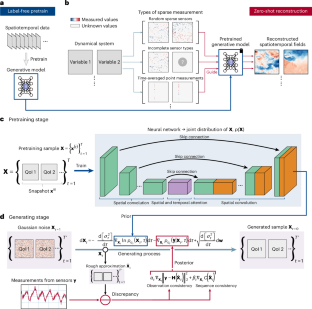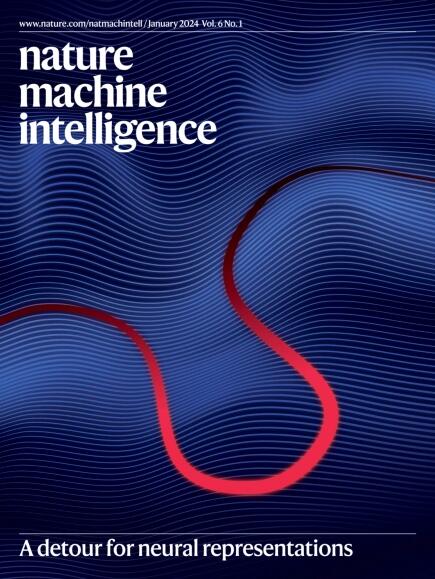Learning spatiotemporal dynamics with a pretrained generative model
IF 18.8
1区 计算机科学
Q1 COMPUTER SCIENCE, ARTIFICIAL INTELLIGENCE
引用次数: 0
Abstract
Reconstructing spatiotemporal dynamics with sparse sensor measurement is a challenging task that is encountered in a wide spectrum of scientific and engineering applications. The problem is particularly challenging when the number or types of sensors (for example, randomly placed) are extremely sparse. Existing end-to-end learning models ordinarily do not generalize well to unseen full-field reconstruction of spatiotemporal dynamics, especially in sparse data regimes typically seen in real-world applications. To address this challenge, here we propose a sparse-sensor-assisted score-based generative model (S3GM) to reconstruct and predict full-field spatiotemporal dynamics on the basis of sparse measurements. Instead of learning directly the mapping between input and output pairs, an unconditioned generative model is first pretrained, capturing the joint distribution of a vast group of pretraining data in a self-supervised manner, followed by a sampling process conditioned on unseen sparse measurement. The efficacy of S3GM has been verified on multiple dynamical systems with various synthetic, real-world and laboratory-test datasets (ranging from turbulent flow modelling to weather/climate forecasting). The results demonstrate the sound performance of S3GM in zero-shot reconstruction and prediction of spatiotemporal dynamics even with high levels of data sparsity and noise. We find that S3GM exhibits high accuracy, generalizability and robustness when handling different reconstruction tasks. Reconstructing and predicting spatiotemporal dynamics from sparse sensor data is challenging, especially with limited sensors. Li et al. address this by using self-supervised pretraining of a generative model, improving accuracy and generalization.


用预训练生成模型学习时空动力学
利用稀疏传感器测量重建时空动态是一项具有挑战性的任务,在广泛的科学和工程应用中遇到。当传感器的数量或类型(例如,随机放置)非常稀疏时,这个问题尤其具有挑战性。现有的端到端学习模型通常不能很好地推广到看不见的时空动态的全场重建,特别是在现实世界应用中常见的稀疏数据体系中。为了解决这一挑战,我们提出了一种稀疏传感器辅助的基于分数的生成模型(S3GM),在稀疏测量的基础上重建和预测全场时空动态。不是直接学习输入和输出对之间的映射,而是首先对无条件生成模型进行预训练,以自监督的方式捕获大量预训练数据的联合分布,然后进行以未见稀疏测量为条件的采样过程。S3GM的有效性已经在多个动力系统上得到了验证,这些系统包括各种合成、现实世界和实验室测试数据集(从湍流模型到天气/气候预报)。结果表明,即使在高数据稀疏度和高噪声的情况下,S3GM在零射击重建和时空动态预测方面也具有良好的性能。我们发现,在处理不同的重建任务时,S3GM具有较高的准确性、泛化性和鲁棒性。
本文章由计算机程序翻译,如有差异,请以英文原文为准。
求助全文
约1分钟内获得全文
求助全文
来源期刊

Nature Machine Intelligence
Multiple-
CiteScore
36.90
自引率
2.10%
发文量
127
期刊介绍:
Nature Machine Intelligence is a distinguished publication that presents original research and reviews on various topics in machine learning, robotics, and AI. Our focus extends beyond these fields, exploring their profound impact on other scientific disciplines, as well as societal and industrial aspects. We recognize limitless possibilities wherein machine intelligence can augment human capabilities and knowledge in domains like scientific exploration, healthcare, medical diagnostics, and the creation of safe and sustainable cities, transportation, and agriculture. Simultaneously, we acknowledge the emergence of ethical, social, and legal concerns due to the rapid pace of advancements.
To foster interdisciplinary discussions on these far-reaching implications, Nature Machine Intelligence serves as a platform for dialogue facilitated through Comments, News Features, News & Views articles, and Correspondence. Our goal is to encourage a comprehensive examination of these subjects.
Similar to all Nature-branded journals, Nature Machine Intelligence operates under the guidance of a team of skilled editors. We adhere to a fair and rigorous peer-review process, ensuring high standards of copy-editing and production, swift publication, and editorial independence.
 求助内容:
求助内容: 应助结果提醒方式:
应助结果提醒方式:


